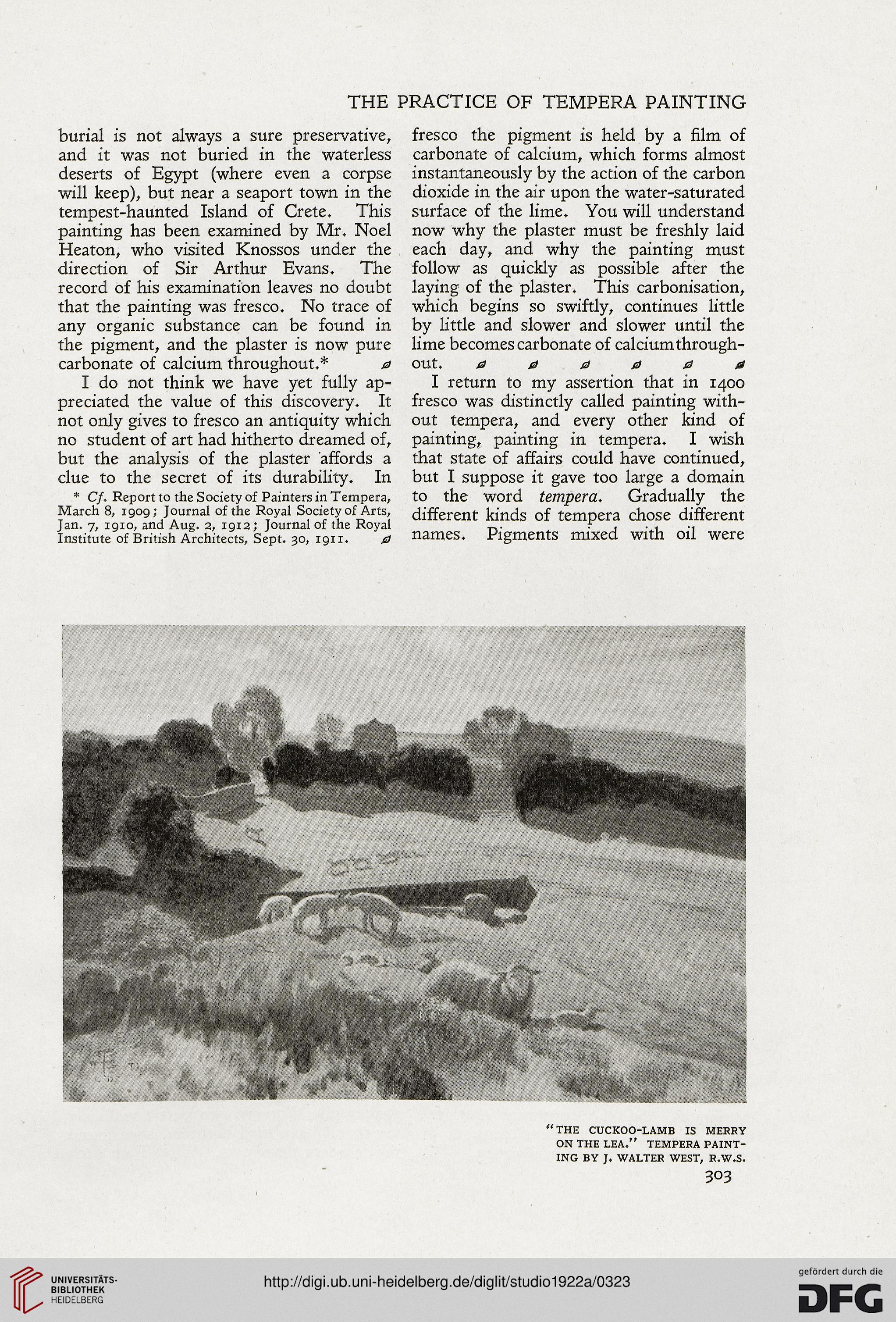THE PRACTICE OF TEMPERA PAINTING
burial is not always a sure preservative,
and it was not buried in the waterless
deserts of Egypt (where even a corpse
will keep), but near a seaport town in the
tempest-haunted Island of Crete. This
painting has been examined by Mr. Noel
Heaton, who visited Knossos under the
direction of Sir Arthur Evans. The
record of his examination leaves no doubt
that the painting was fresco. No trace of
any organic substance can be found in
the pigment, and the plaster is now pure
carbonate of calcium throughout.* a
I do not think we have yet fully ap-
preciated the value of this discovery. It
not only gives to fresco an antiquity which
no student of art had hitherto dreamed of,
but the analysis of the plaster affords a
clue to the secret of its durability. In
* Cf. Report to the Society of Painters in Tempera,
March 8, 1909; Journal of the Royal Society of Arts,
Jan. 7, 1910, and Aug. 2, 1912; Journal of the Royal
Institute of British Architects, Sept. 30, 1911. 0
fresco the pigment is held by a film of
carbonate of calcium, which forms almost
instantaneously by the action of the carbon
dioxide in the air upon the water-saturated
surface of the lime. You will understand
now why the plaster must be freshly laid
each day, and why the painting must
follow as quickly as possible after the
laying of the plaster. This carbonisation,
which begins so swiftly, continues little
by little and slower and slower until the
lime becomes carbonate of calcium through-
out, a 0 0 0 a a
I return to my assertion that in 1400
fresco was distinctly called painting with-
out tempera, and every other kind of
painting, painting in tempera. I wish
that state of affairs could have continued,
but I suppose it gave too large a domain
to the word tempera. Gradually the
different kinds of tempera chose different
names. Pigments mixed with oil were
"THE CUCKOO-LAMB IS MERRY
ON THE LEA." TEMPERA PAINT-
ING BY J. WALTER WEST, R.W.S.
303
burial is not always a sure preservative,
and it was not buried in the waterless
deserts of Egypt (where even a corpse
will keep), but near a seaport town in the
tempest-haunted Island of Crete. This
painting has been examined by Mr. Noel
Heaton, who visited Knossos under the
direction of Sir Arthur Evans. The
record of his examination leaves no doubt
that the painting was fresco. No trace of
any organic substance can be found in
the pigment, and the plaster is now pure
carbonate of calcium throughout.* a
I do not think we have yet fully ap-
preciated the value of this discovery. It
not only gives to fresco an antiquity which
no student of art had hitherto dreamed of,
but the analysis of the plaster affords a
clue to the secret of its durability. In
* Cf. Report to the Society of Painters in Tempera,
March 8, 1909; Journal of the Royal Society of Arts,
Jan. 7, 1910, and Aug. 2, 1912; Journal of the Royal
Institute of British Architects, Sept. 30, 1911. 0
fresco the pigment is held by a film of
carbonate of calcium, which forms almost
instantaneously by the action of the carbon
dioxide in the air upon the water-saturated
surface of the lime. You will understand
now why the plaster must be freshly laid
each day, and why the painting must
follow as quickly as possible after the
laying of the plaster. This carbonisation,
which begins so swiftly, continues little
by little and slower and slower until the
lime becomes carbonate of calcium through-
out, a 0 0 0 a a
I return to my assertion that in 1400
fresco was distinctly called painting with-
out tempera, and every other kind of
painting, painting in tempera. I wish
that state of affairs could have continued,
but I suppose it gave too large a domain
to the word tempera. Gradually the
different kinds of tempera chose different
names. Pigments mixed with oil were
"THE CUCKOO-LAMB IS MERRY
ON THE LEA." TEMPERA PAINT-
ING BY J. WALTER WEST, R.W.S.
303




